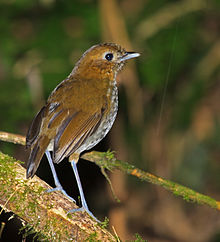Fenwick's antpitta
| Urrao antpitta | |
|---|---|
 |
|
| Scientific classification | |
| Kingdom: | Animalia |
| Phylum: | Chordata |
| Class: | Aves |
| Order: | Passeriformes |
| Family: | Grallariidae |
| Genus: | Grallaria |
| Species: | G. fenwickorum or G. urraoensis |
| Binomial name | |
|
Grallaria fenwickorum or Grallaria urraoensis Barrera and Bartels, 2010 (fenwickorum), Carantón-Ayala and Certuche-Cubillos, 2010 (urraoensis) |
|
The Urrao antpitta or Fenwick's antpitta (Grallaria urraoensis or fenwickorum) is a highly threatened species of bird found in the understory of cloud forest in the Andean highlands of Colombia. Its description has caused considerable controversy. The first published description used the scientific name Grallaria fenwickorum (and English name Fenwick's antpitta); shortly afterward, a second description using the name Grallaria urraoensis was published. The editors of the latter recognized that the name likely was a junior synonym, but others have questioned if the first description was valid, and various authorities, including the International Ornithological Congress (followed here for English-language names), have adopted G. urraoensis. Antioquia antpitta has been suggested as an English-language name compromise.
The new species was discovered during banding sessions in September 2007 and February and March 2008 when Diego Carantón, then working as a researcher for a Colombian NGO, Fundación ProAves de Colombia, caught an unfamiliar Grallaria antpitta. It was also sound-recorded in late 2008. The population was thought to be a new species and was added to the Colombian checklist as "Grallaria sp." in 2009. Since 2008 many ornithologists and birders have seen, photographed, recorded and studied the new bird at the reserve, where a family party is seen daily at a feeding station alongside chestnut-naped antpittas. Luis Felipe Barrera and Avery Bartels, the authors of the description under the name Grallaria fenwickorum, based it on holotypic material from a living bird, but also included information based on two specimens that Carantón had collected earlier.
Their holotype comprises 14 feathers, taken from the wing, tail and body of a living bird which was banded, photographed, sound-recorded and measured in the field before being released, on 11 January 2010. In the description it was stated that the holotype material had been deposited, as tissue collection No. 699, at the José Celestino Mutis Natural History Museum of the Faculty of Sciences of the University of Pamplona. This was denied by people associated with the museum, which has neither a tissue collection nor anything deposited under No. 699. An associate of the museum did receive an envelope with the feathers, but he was not informed about its great significance and it was not moved to the collection until after the description of the new species. The museum does not have an ornithological curator or the means to preserve such an important sample. Consequently they have forwarded the material to the relevant authorities to allow them to take charge in its depositing and preservation.
...
Wikipedia

